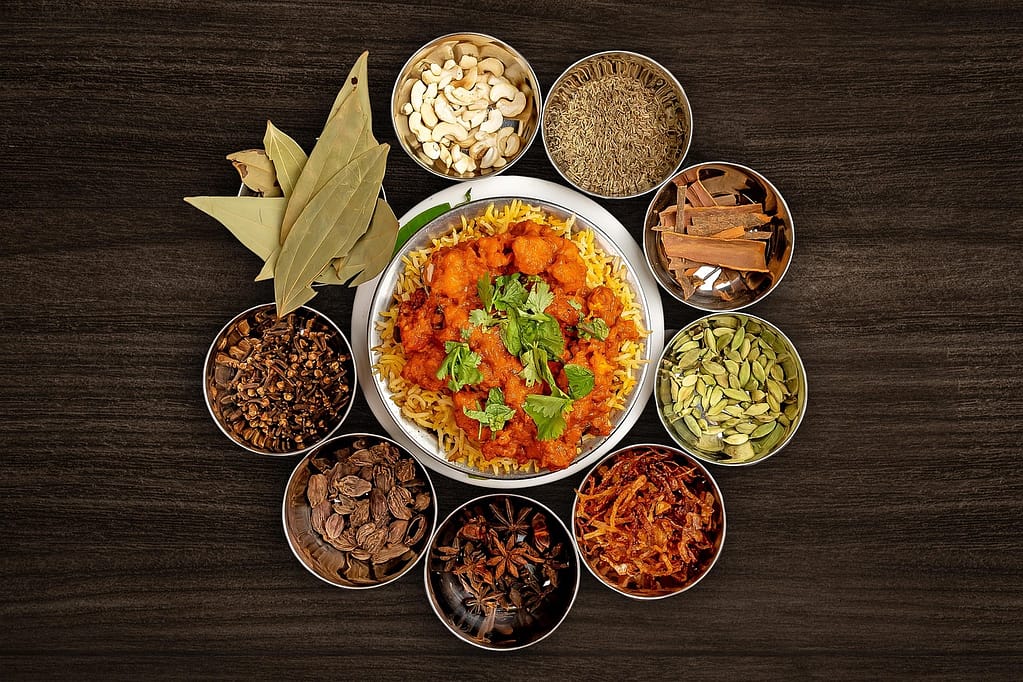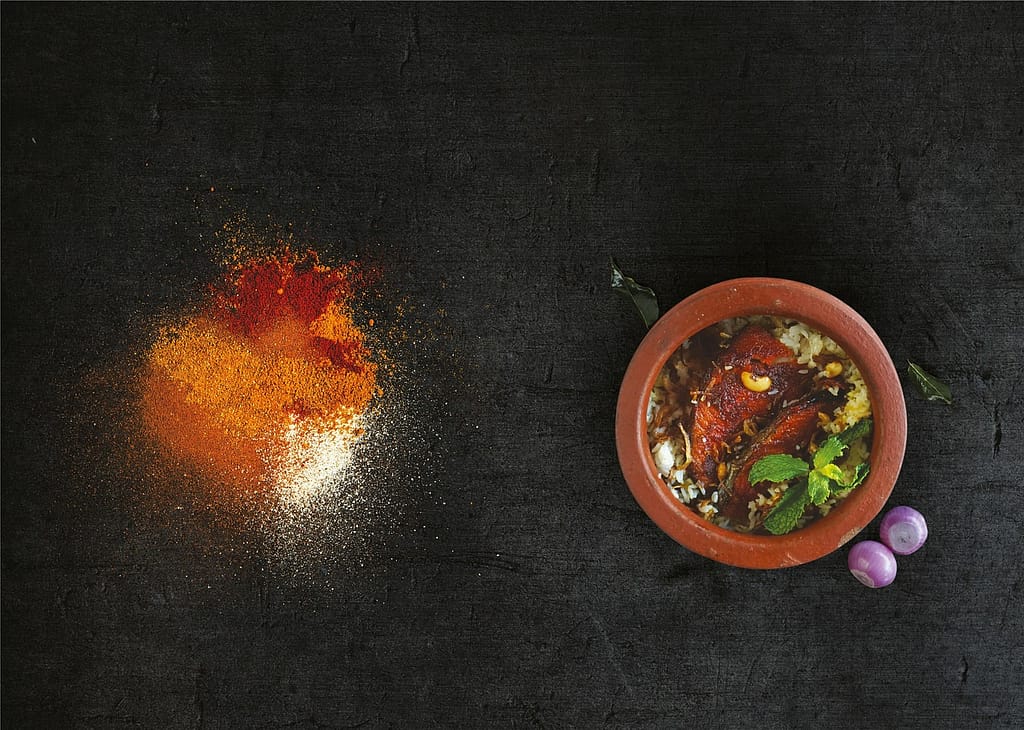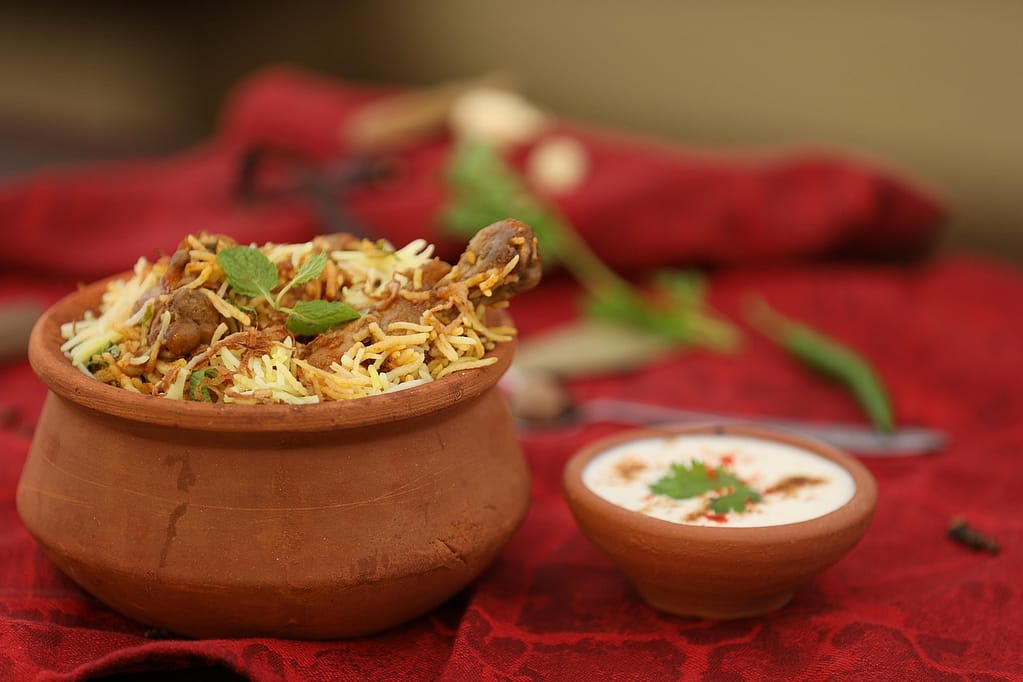Biryani isn’t just a dish—it’s an experience, a celebration of spices, textures, and aroma that transcends regional and cultural boundaries. Believed to have been brought to the Indian subcontinent by Persian travelers and traders, biryani has evolved into many regional variations across India, Pakistan, and beyond. From the regal Hyderabadi biryani to the coastal flavors of Kerala biryani, each version is unique yet rooted in the same culinary tradition.
In this article, we’ll walk you through a classic chicken biryani recipe—layered, flavorful, and cooked to perfection.
Ingredients
For the Rice:
- 2 cups basmati rice
- 6 cups water
- 4–5 green cardamom pods
- 4 cloves
- 1 bay leaf
- 1 cinnamon stick
- Salt to taste
For the Chicken Marinade:
- 500g chicken (bone-in pieces preferred)
- 1 cup yogurt
- 1 tablespoon ginger-garlic paste
- 1 teaspoon turmeric powder
- 1.5 teaspoons red chili powder
- 1 teaspoon garam masala
- Salt to taste
- Juice of half a lemon
For the Biryani:
- 2 large onions, thinly sliced
- 2 tablespoons cooking oil
- 2 tablespoons ghee (clarified butter)
- A pinch of saffron soaked in 2 tablespoons warm milk (optional)
- 1/4 cup chopped coriander (cilantro)
- 1/4 cup chopped mint leaves
Instructions
Step 1: Marinate the Chicken
In a large bowl, mix the yogurt, ginger-garlic paste, turmeric, chili powder, garam masala, salt, and lemon juice. Add chicken pieces and coat well. Cover and refrigerate for at least 1 hour (overnight is ideal for deeper flavor).
Step 2: Prepare the Rice
Rinse the basmati rice in cold water until the water runs clear. Boil water in a large pot with the whole spices and salt. Add the rice and cook until it’s 70–80% done—grains should still be firm. Drain and set aside.
Step 3: Fry the Onions
Heat oil in a deep pan or Dutch oven. Add sliced onions and fry until golden brown and crisp. Remove half of them for garnishing and keep the rest in the pan.
Step 4: Cook the Chicken
Add the marinated chicken to the pan with the remaining onions. Cook on medium-high heat until the chicken is browned and cooked through, about 10–15 minutes. You can add a splash of water if the masala gets too dry.
Step 5: Layer the Biryani
Reduce the heat. Spread half of the cooked rice over the chicken. Sprinkle some chopped mint, coriander, and fried onions. Add the remaining rice and repeat the garnish. Drizzle with ghee and saffron milk if using.
Step 6: Dum Cooking (Steam Cooking)
Cover the pot with a tight-fitting lid or seal it with dough. Cook on very low heat for 20–25 minutes. Alternatively, you can place a heavy skillet or tawa beneath the pot to prevent burning.
Read also: Mineral water in Rajasthan
Serving the Biryani
Let the biryani rest for 10 minutes before gently fluffing it up with a spoon. Serve hot with raita (yogurt sauce), salad, and a wedge of lemon.
Tips for Perfect Biryani
- Use aged basmati rice for the best texture and aroma.
- Fry onions patiently on medium heat for even browning—they add richness and sweetness.
- Marination is key—the longer you marinate, the deeper the flavor.
- Don’t overcook the rice; it will continue cooking during the dum process.
- For a vegetarian version, substitute chicken with paneer or mixed vegetables.
Final Thoughts
Making biryani at home may seem complex at first, but it’s incredibly rewarding. The layers of flavor, the visual beauty, and the unmatched aroma make biryani a dish worth mastering. Whether for a festive occasion or a weekend family dinner, this iconic recipe brings warmth, tradition, and taste to the table.
Would you like this article formatted for a printable recipe card or blog post? I can also customize it for vegetarian, seafood, or regional versions like Hyderabadi or Kolkata biryani.Biryani isn’t just a dish—it’s an experience, a celebration of spices, textures, and aroma that transcends regional and cultural boundaries. Believed to have been brought to the Indian subcontinent by Persian travelers and traders, biryani has evolved into many regional variations across India, Pakistan, and beyond. From the regal Hyderabadi biryani to the coastal flavors of Kerala biryani, each version is unique yet rooted in the same culinary tradition.
In this article, we’ll walk you through a classic chicken biryani recipe—layered, flavorful, and cooked to perfection.
Ingredients
For the Rice:
- 2 cups basmati rice
- 6 cups water
- 4–5 green cardamom pods
- 4 cloves
- 1 bay leaf
- 1 cinnamon stick
- Salt to taste

For the Chicken Marinade:
- 500g chicken (bone-in pieces preferred)
- 1 cup yogurt
- 1 tablespoon ginger-garlic paste
- 1 teaspoon turmeric powder
- 1.5 teaspoons red chili powder
- 1 teaspoon garam masala
- Salt to taste
- Juice of half a lemon

For the Biryani:
- 2 large onions, thinly sliced
- 2 tablespoons cooking oil
- 2 tablespoons ghee (clarified butter)
- A pinch of saffron soaked in 2 tablespoons warm milk (optional)
- 1/4 cup chopped coriander (cilantro)
- 1/4 cup chopped mint leaves
Instructions
Step 1: Marinate the Chicken
In a large bowl, mix the yogurt, ginger-garlic paste, turmeric, chili powder, garam masala, salt, and lemon juice. Add chicken pieces and coat well. Cover and refrigerate for at least 1 hour (overnight is ideal for deeper flavor).
Step 2: Prepare the Rice
Rinse the basmati rice in cold water until the water runs clear. Boil water in a large pot with the whole spices and salt. Add the rice and cook until it’s 70–80% done—grains should still be firm. Drain and set aside.
Step 3: Fry the Onions
Heat oil in a deep pan or Dutch oven. Add sliced onions and fry until golden brown and crisp. Remove half of them for garnishing and keep the rest in the pan.
Step 4: Cook the Chicken
Add the marinated chicken to the pan with the remaining onions. Cook on medium-high heat until the chicken is browned and cooked through, about 10–15 minutes. You can add a splash of water if the masala gets too dry.
Step 5: Layer the Biryani
Reduce the heat. Spread half of the cooked rice over the chicken. Sprinkle some chopped mint, coriander, and fried onions. Add the remaining rice and repeat the garnish. Drizzle with ghee and saffron milk if using.
Step 6: Dum Cooking (Steam Cooking)
Cover the pot with a tight-fitting lid or seal it with dough. Cook on very low heat for 20–25 minutes. Alternatively, you can place a heavy skillet or tawa beneath the pot to prevent burning.

Serving the Biryani
Let the biryani rest for 10 minutes before gently fluffing it up with a spoon. Serve hot with raita (yogurt sauce), salad, and a wedge of lemon.
Tips for Perfect Biryani
- Use aged basmati rice for the best texture and aroma.
- Fry onions patiently on medium heat for even browning—they add richness and sweetness.
- Marination is key—the longer you marinate, the deeper the flavor.
- Don’t overcook the rice; it will continue cooking during the dum process.
- For a vegetarian version, substitute chicken with paneer or mixed vegetables.

Final Thoughts
Making biryani at home may seem complex at first, but it’s incredibly rewarding. The layers of flavor, the visual beauty, and the unmatched aroma make biryani a dish worth mastering. Whether for a festive occasion or a weekend family dinner, this iconic recipe brings warmth, tradition, and taste to the table.
Would you like this article formatted for a printable recipe card or blog post? I can also customize it for vegetarian, seafood, or regional versions like Hyderabadi or Kolkata biryani.